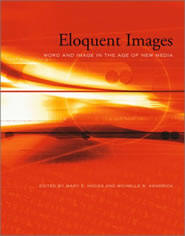
Home / Introduction / Part I / Part II / Part III / Part IV / Conclusion

Introduction:
Originally published in 2003 by MIT Press and then in a paperback edition in 2005, Mary E. Hocks and Michelle R. Kendrick's Eloquent Images: Word and Image in the Age of New Media provides readers with an interesting collection of thirteen essays focused on the emergence of new media. Divided into four parts, the book explores the complex relationships between image and word and presents the ongoing conversations in the fields of humanities, specifically taking into consideration the rhetorical and cultural studies of image and word. The theme of the book centers on the idea that new media should not be described as a revolution, but rather should be considered more like an evolution, meaning that new media has built upon the already existing dynamic relationship between image and word, a theory of remediation developed by Bolter and Grusin.
Each essay contributes to the theme either by either exploring past theories, by providing ways to talk about new media, or offering practical examples of new media applications. While some of the contributors' findings and claims might seem outdated and obvious today, the authors on a whole still touch on beliefs that are crucial to today's conversation about new media. Scholars and practitioners may find this collection useful for its historical perspective. For instance, readers might consider how the relationship between hypermedia and humanities as described by Ellen Strain and Gregory VanHoosier-Carey has changed since the book was first published or how authoring fictional stories in virtual reality differ from the authoring processes undertaken by Josephine Anstey. Practitioners might also find Kevin LaGrandeur's essay to be a reminder of how we can still use classical rhetoric to analyze present day multimedia and Jennifer Wiley's essay to be a guide of how and when we should incorporate image adjuncts into our texts.
Home / Introduction / Part I / Part II / Part III / Part IV / Conclusion